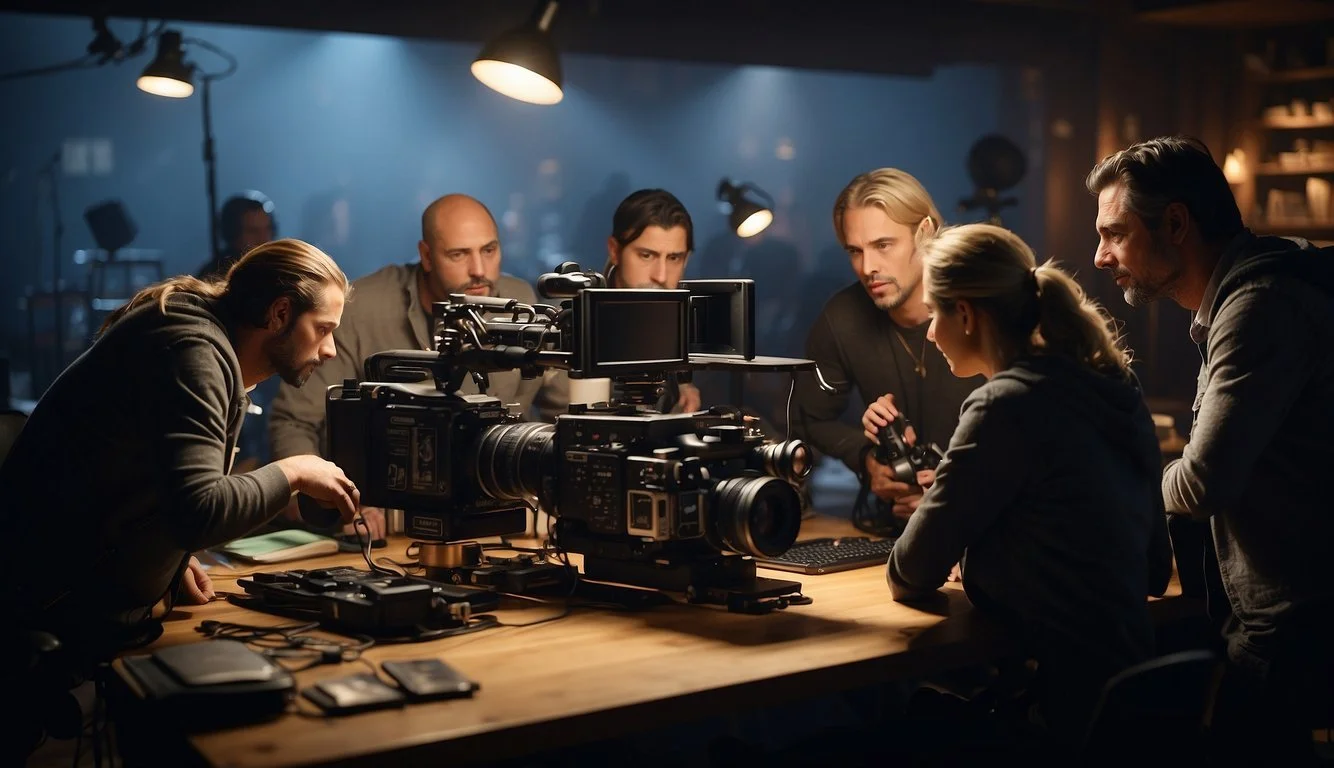Documentary Review: At Home with the Furys (2023)
A Deep Dive into Family Dynamics
"At Home with the Furys" is a captivating docu-series that offers a revealing look into the life of heavyweight champion Tyson Fury and his family. This Netflix series stands out by shining a light on Fury's struggles with mental health, making it a must-watch for both boxing fans and those interested in personal stories of resilience and vulnerability. Critics have praised the show for its honest depiction of mental health issues, providing a nuanced view of the champion beyond the boxing ring.
The series dives into Fury's post-retirement life, showcasing interactions with his wife Paris, his father John, and their six children. While the show maintains an entertaining and sometimes whimsical tone, it does not shy away from the challenges faced by the family. This balance of light-hearted moments and serious discussions makes the show both engaging and thought-provoking.
Tyson Fury's children also emerge as prominent figures in the series, with the eldest son Prince delivering candid and sometimes humorous insights. The family dynamics, combined with the personal revelations and candid moments, create a compelling narrative that keeps viewers hooked from start to finish.
Overview of 'At Home with the Furys'
The documentary series provides an intimate glimpse into the life of heavyweight champion Tyson Fury as he navigates retirement, family life, and personal challenges. It combines engaging storytelling with a candid portrayal of mental health and family dynamics.
Synopsis
At Home with the Furys follows Tyson Fury, the WBC heavyweight champion, as he steps away from the boxing ring to embrace retirement. The series highlights his interactions with his family, including his wife, Paris, their children, and other close relatives. It covers various facets of his life, from everyday family moments to his struggles with mental health.
Episodes focus on different aspects of Fury's post-retirement life. The narrative balances between his public persona and private life, offering viewers a holistic view of the man behind the title. Key themes include the challenges of adapting to a slower-paced life, the joys and trials of parenting, and the constant battle with mental health issues.
Filmmaking Style
The documentary adopts a fly-on-the-wall approach, capturing the day-to-day activities of the Fury family without excessive scripting. This style allows for a more authentic and spontaneous portrayal of their lives. Cinematography is straightforward, focusing on intimate, candid moments rather than stylized visuals.
The series also uses confessionals, where family members, especially the children, directly address the camera. This technique adds depth to the narrative by providing personal insights and unfiltered thoughts. The editing is brisk, ensuring the pacing maintains viewer engagement while transitioning smoothly between different scenes and story arcs.
Initial Reception
Critics have generally praised At Home with the Furys for its honest depiction of Tyson Fury's mental health struggles and family life. Reviews highlight the balance the series strikes between being entertaining and insightful. The candid moments, especially those involving Fury's children, have been particularly well-received for their authenticity and charm.
Viewers and critics appreciate the series' ability to shed light on serious topics while maintaining a light-hearted tone. Ratings have been favorable, and its renewal for a second season indicates a positive reception from the audience. The blend of humor, raw emotion, and familial warmth has resonated well with many.
Contextual Background
The documentary "At Home with the Furys" delves into the life of Tyson Fury and his family. The context behind this series is enriched by the legacy of the Fury family in boxing and the cultural significance of boxing documentaries.
The Fury Family Legacy
The Fury family is prominent in the world of boxing, led by heavyweight champion Tyson Fury. Known as "The Gypsy King," Tyson Fury's impressive career includes defeating legendary fighters like Wladimir Klitschko and Deontay Wilder. His father, John Fury, also contributed to the family's boxing tradition and played a significant role in Tyson's training and development.
Tyson's brothers, Tommy and Shane Fury, have also pursued careers in boxing, contributing to the family's reputation in the sport. Tommy Fury gained additional fame through his participation in the reality TV show "Love Island," adding a pop culture dimension to the family's public persona.
Cultural Impact of Boxing Documentaries
Boxing documentaries have a rich history of capturing the triumphs and struggles of fighters. They provide audiences with an in-depth look into the lives of athletes beyond the ring. Notable examples include the critically acclaimed "When We Were Kings" and the iconic "Rumble in the Jungle" bout.
"At Home with the Furys" offers an intimate view of Tyson Fury's life post-retirement, highlighting his mental health journey and family dynamics. This aligns with the increasing trend of sports documentaries focusing on personal and emotional aspects, resonating with a broad audience. The series serves as an important cultural artifact, showcasing the humanity behind a public figure known for his prowess in the ring.
Content Analysis
"At Home with the Furys" (2023) delves into various aspects of Tyson Fury's life, emphasizing his mental health struggles while capturing the essence of his family dynamics. It stands out from other sports documentaries by offering a transparent look into the personal and professional life of a heavyweight champion.
Themes Explored
The documentary covers several key themes, such as mental health and its impact on professional athletes. Tyson Fury's battle with depression and anxiety receives significant attention, showcasing his journey toward managing these challenges.
The series also touches on family life, highlighting the importance of support networks. Religion, perseverance, and identity are explored, revealing how these factors influence Fury's outlook on life and boxing career. Behind-the-scenes footage offers insights into the balance between fame and normalcy.
Portrayal of Family Dynamics
"At Home with the Furys" provides an intimate look at Tyson Fury's family, including his wife Paris, children, and extended family. The interactions among family members offer a candid view of their relationships.
The children, especially eldest son Prince, have standout moments. Their presence adds authenticity to the series, portraying both the challenges and joys of raising a family under public scrutiny. The docu-series balances moments of conflict with heartfelt scenes of unity, thereby painting a comprehensive picture of their day-to-day lives.
Contrast with Previous Sports Documentaries
Unlike traditional sports documentaries that focus primarily on athletic achievements, "At Home with the Furys" blends personal and professional spheres. The candid approach draws contrasts with other productions, which often glorify the athlete's success while glossing over personal issues.
This series' transparency about mental health sets it apart, offering a more humanized portrayal of its subject. Additionally, the fly-on-the-wall style adopted by the production crew allows for spontaneous and unscripted moments, differing from the highly curated and polished nature of other sports documentaries. The commitment to showing raw, unfiltered reality provides viewers with a more relatable and holistic perspective of Tyson Fury’s life.
Cinematography and Editing Techniques
The documentary "At Home with the Furys" employs strategic cinematography and precise editing techniques to enhance the narrative and emotional impact. Through thoughtful visual storytelling and rhythmic editing, it captures the essence of Tyson Fury's life both inside and outside the boxing ring.
Visual Storytelling
The documentary makes use of close-up shots and wide-angle views to immerse the audience in the emotional highs and lows of the Fury family's daily life. Close-up shots highlight intimate, revealing moments, such as Tyson Fury's candid discussions about his mental health or interactions with his children.
Wide-angle shots, often used during family gatherings or training sessions, provide a comprehensive view of the environment, emphasizing the collective dynamic of the Fury household.
Lighting plays a crucial role, with natural light often used to maintain an authentic and relatable atmosphere. The color palette typically balances muted tones to reflect the documentary's grounded, real-life subject matter.
Editing Rhythm
The editing rhythm of "At Home with the Furys" skillfully balances the documentary's dual focus on personal and public life. Quick cuts are used during dynamic sequences, such as training and public events, to convey urgency and intensity.
In contrast, slower pacing dominates the personal, introspective moments, allowing the audience to fully engage with the emotional weight of the scenes. Transitions between scenes are seamlessly executed, with emphasis on smooth cross-dissolves and fade-ins to maintain a natural flow.
The editors incorporate reaction shots to enhance narrative continuity, ensuring each segment feels interconnected. These techniques collectively ensure that the documentary's pace aligns with the unfolding story, maintaining viewer engagement while respecting the authenticity of the featured experiences.
Performance and Contribution of Interviewees
The performances of the interviewees in "At Home with the Furys" lend significant depth to the documentary, providing both personal and expert perspectives on Tyson Fury's life and mental health.
Insights from the Furys
Tyson Fury and his family openly discuss their lives, revealing intimate details about their personal challenges and triumphs. The raw honesty from Tyson regarding his mental health struggles adds a layer of authenticity.
Family members, including Tyson's wife Paris and their children, contribute heartfelt accounts that highlight the importance of family support. The children's lighthearted moments provide a stark contrast to the more serious discussions, adding balance and warmth to the narrative.
Expert Opinions
Mental health professionals and boxing experts provide context to Tyson Fury's experiences. Their insights help to frame Tyson's journey within broader societal and psychological frameworks.
Experts discuss the pressures of professional boxing and the complexities of mental health, giving viewers a comprehensive understanding of Tyson's struggles and triumphs. Their contributions help underscore the significance of Tyson's advocacy for mental health, offering a well-rounded view of his impact beyond the ring.
Critique of Direction and Production
The direction and production of At Home with the Furys play a crucial role in shaping the viewer's experience. Directorial choices influence the portrayal of Tyson Fury's transition from a boxing ring to domestic life, while production values determine the overall quality and cohesiveness of the series.
Directorial Decisions
The direction by the series' creators highlights Tyson Fury's larger-than-life personality and complex emotional state. They effectively contrast his intense career with his domestic struggles, providing a well-rounded view of his life.
There is a notable focus on moments that underscore the challenges of retirement and mental health, a choice that adds depth to the narrative. The directors have balanced these serious themes with lighter, everyday family interactions.
Using a mix of candid shots and more structured scenes, the direction maintains viewer engagement. Character development is emphasized, allowing the audience to connect with not just Tyson, but also his family members.
Production Values
High production values contribute significantly to the series' appeal. Filming in high definition, the visuals are crisp and vibrant, adding to the immersive experience. The production team ensures that intimate, domestic scenes contrast sharply with the grandeur of Tyson's boxing history.
Sound quality is consistently excellent, with clear audio that captures everything from boisterous family moments to quieter, more reflective scenes. The editing is tight, helping to keep the pacing brisk and engaging.
Locations are thoughtfully selected, showcasing Tyson's opulent home and various personal spaces that add authenticity. This attention to detail in production helps build a more compelling and believable narrative world.
Public and Critical Reception
The reception of "At Home with the Furys" has been shaped by both audience reactions and critical reviews. Feedback varies but often highlights the show's approach to mental health and its depiction of Tyson Fury's life away from the boxing ring.
Audience Response
Audiences have been notably captivated by the candid portrayal of Tyson Fury's personal battles and family dynamics. The series has received praise for its honest representation of mental health challenges. Many viewers appreciate the raw, unfiltered look into the life of a celebrated athlete dealing with everyday issues. Social media buzz and viewer reviews often highlight how relatable and human the Fury family appears, which has fostered a connection with the audience. Some fans had mixed feelings, finding certain parts of the show slightly staged or contrived, yet they still acknowledge the genuine moments that outweigh these scripted elements.
Critical Reviews
Critics have offered a range of perspectives on the documentary series. Many have commended the show's commitment to addressing mental health, with reviews from outlets like the BBC noting its importance. Some have likened Tyson to a modern-day Ozzy Osbourne, with his intense career juxtaposed against his domestic life. Despite this, there are views that the series can feel lightweight at times. Rotten Tomatoes gave it a mixed rating of 3 out of 5, pointing out that while it maintains a dignified tone, there's a sense of contrivance. Nonetheless, the transparency about Tyson's struggles has been recognized as a significant positive aspect.
Conclusion
This series shines a spotlight on Tyson Fury's personal life and his struggles with mental health, offering audiences an up-close look at the dynamics of his family and his transition into retirement.
Summary of Key Points
"At Home with the Furys" stands out for its candid portrayal of Tyson Fury's mental health battles. Critics have appreciated the series for its transparency, despite noting moments that felt somewhat staged.
The documentary features not only Tyson but also his wife Paris and their six children, providing an intimate glimpse into their family life. Tyson's eldest son, Prince, has been particularly noted for his straightforward and engaging presence on camera.
Final Thoughts
The documentary has been praised for its honest depiction of mental health issues, setting it apart from other celebrity reality shows. While some reviewers felt the series could be lightweight at times, the inclusion of genuine emotional struggles adds depth.
The show contrasts with more glitzy, dramatized reality TV, offering a more grounded perspective with elements similar to family-centric series like "The Osbournes" rather than "Keeping Up with the Kardashians."
This approach makes it a distinctive and refreshing entry in the genre, resonating with viewers looking for authenticity. Whether you're a boxing fan or not, "At Home with the Furys" offers valuable insights into coping with mental health while balancing family life.







